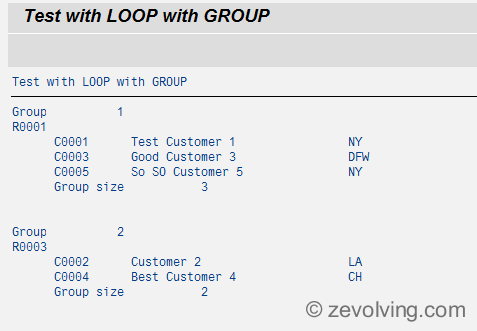
or READ TABLE itab into data(wa) WITH KEY field1 var1. or READ TABLE itab into wa WITH KEY field1 var1. DATA wa TYPE structure LOOP AT itab INTO wa. Declaration of the work area while operation on Internal Table, Old Syntax. Read about more such ABAP expressions and exciting new syntaxes: ABAP Expressions (7. INTO TABLE DATA(itab) WHERE fld1 var1 AND fld2 var2.

WRITE: / booking_gr_2->customid, booking_gr_2->size. GROUP BY ( customid = booking_gr-customid And unlike AT – you don’t need the fields used in combinations to be the first in the table structure.įor example, below will also work.
Abap 7.4 loop at itab code#
So, by using LOOP AT… GROUP BY you can get rid of the AT statements, make the code cleaner. WRITE: / booking_gr_2->index LEFT-JUSTIFIED, LOOP AT bookings INTO DATA(booking_gr)ĪSCENDING REFERENCE INTO DATA(booking_gr_2). Here, you can get the index for the group and size of the group i.e. SPLIT xstr AT CONV xstring ( 20 ) INTO TABLE DATA (xtab) IN BYTE MODE. DATA (xstr) clabapcodepage>convertto ( Like a Hurricane ). Note that a explicit reference is used to get the data. The byte string xstr is split at bytes with the value hexadecimal 20, which stands for a blank in code page UTF-8, into an internal table with row type xstring. WITHOUT MEMBERS REFERENCE INTO DATA(booking_gr_2). WITHOUT MEMBERS – Get unique values without requirement to loop on group members.

To loop on this you need to use LOOP AT GROUP.ġ. This creates a deep structure booking_gr which has fields from the group by clause (carrid, connid, fldate) and the table entries which match this combination. LOOP AT GROUP booking_gr ASSIGNING FIELD-SYMBOL(). Total_weight = total_weight + -luggweight.įor simplicity – let us look at the code without the write statements. LOOP AT GROUP booking_gr ASSIGNING FIELD-SYMBOL(). WRITE: / booking_gr-carrid, 9 booking_gr-connid, Advertisements WRITE: 'Carrier', 9 'Connection', 21 'Flight Date'. The same output can be achieved in ABAP 7.4 using the LOOP AT. DATA: BEGIN OF wa, col1 TYPE i, col2 TYPE i, END OF wa, itab LIKE TABLE OF wa WITH EMPTY. Or you can do it in one statement: APPEND VALUE (. The same output can be achieved in ABAP 7.4 using the LOOP AT. You can then use that field symbol to fill the table entry using the same VALUE construct you are using now. Total_weight = total_weight + booking-luggweight. The index logic is pretty ugly, you can easily use the ASSIGNING addition to the APPEND command to get a field symbol to the newly added line. WRITE: /35 booking-customid, 50 booking-luggweight. WRITE: / booking-carrid, 9 booking-connid, It is more critical when we use the inline declaration because it creates only standard-type tables. We will always have to consider the data volume for the internal tables to avoid possible performance issues. The control goes into the AT… ENDAT blocks as per below table.įor example, to print sum of total luggage weight per CARRID, CONNID, FLDATE combination using AT statements would look like below. Since SAP NetWeaver ABAP 7.4 introduced this new feature, it has been the preferred way over explicit data declaration.

Executed when the combination of fields up to the field mentioned after AT NEW changes.Can be used to write headers for report.Executed on the first record of the table.In short, there are 4 AT statements which can be used inside a LOOP to produce summarization data. You can refer SCN wiki Control Level Statements in ABAP – ABAP Development – Community Wiki (sap.com) to learn about the AT… END AT control level statements. This statement can be used instead of using AT NEW… END AT statements. The byte string xstr is split at bytes with the value hexadecimal 20, which stands for a blank in code page UTF-8, into an internal table with row type xstring.ĭATA(xstr) = cl_abap_codepage=>convert_to( `Like a Hurricane` ).Ĭl_demo_output=>write( cl_abap_codepage=>convert_from( xstr ) ).In this post, you will learn about LOOP AT… GROUP BY statement introduced in 7.40. or the rows of the internal table result_tab must be byte-like or character-like. On the type of processing, the operands dobj, sep,Īnd the target fields result1 result2. If the addition is not specified, character string processing is carried out.

MODE determines whetherĬharacter string or byte string processing Statements for Character String and Byte String Processing → ABAP - Keyword Documentation →Ĭharacter String and Byte String Processing → SAP NetWeaver AS ABAP Release 752, ©Copyright 2017 SAP AG.


 0 kommentar(er)
0 kommentar(er)
